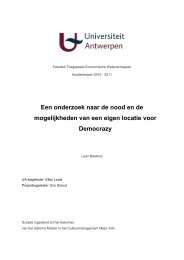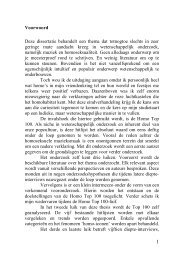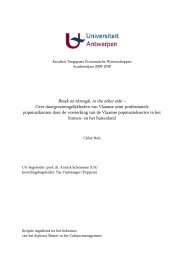Hip hop identity in a township reality. - Poppunt
Hip hop identity in a township reality. - Poppunt
Hip hop identity in a township reality. - Poppunt
Create successful ePaper yourself
Turn your PDF publications into a flip-book with our unique Google optimized e-Paper software.
The unemployment rate is very high, with an estimated 70% of the population<br />
hav<strong>in</strong>g no job. 40% of the people have had no school<strong>in</strong>g at all, or attended only a<br />
few years at primary school, only 12% has obta<strong>in</strong>ed his or her matriculation or<br />
attended higher education. There is also a grow<strong>in</strong>g poverty, with a lot of households<br />
depend<strong>in</strong>g on state grants or employed family members for subsistence. 33% has<br />
no <strong>in</strong>come at all, 25% earns less than R 1.200 (144 €) per year and 41% less than R<br />
18.000 (2160 €) per year (IJR – Institute for Justice and Reconciliation 13 ).<br />
All of these figures, together with the poor liv<strong>in</strong>g conditions and <strong>in</strong>adequate access<br />
to social and recreational facilities, result <strong>in</strong> social problems, such as alcohol or<br />
other substance abuse, gangsterism, child abuse and so on (IJR – Institute for<br />
Justice and Reconciliation).<br />
4. History of hip <strong>hop</strong> <strong>in</strong> Cape Town<br />
In this part of the <strong>in</strong>troduction we want to give a brief outl<strong>in</strong>e of the orig<strong>in</strong>s of hip<br />
<strong>hop</strong> <strong>in</strong> Cape Town. We did not f<strong>in</strong>d a lot of sources to document this overview, nor<br />
did we pay a lot of attention to it <strong>in</strong> the <strong>in</strong>terviews we did. This is rather<br />
unfortunate, s<strong>in</strong>ce we only realised afterwards that this history is a very fasc<strong>in</strong>at<strong>in</strong>g<br />
matter and it did spark our curiosity just a bit too late. Most of the quotes <strong>in</strong> this<br />
part are from Emile YX?, because we did ask him about the early days of hip <strong>hop</strong> <strong>in</strong><br />
Cape Town, although also rather briefly.<br />
Still before the commercial breakthrough of hip <strong>hop</strong> <strong>in</strong> the USA, from the mid and<br />
late eighties on, hip <strong>hop</strong> emerged on the Cape Flats <strong>in</strong> the early eighties, with 1982<br />
as often mentioned year to mark some k<strong>in</strong>d of start<strong>in</strong>g po<strong>in</strong>t. At that moment,<br />
especially b-boy<strong>in</strong>g (breakdanc<strong>in</strong>g) and writ<strong>in</strong>g (graffiti) were the most popular<br />
elements of the hip <strong>hop</strong> culture on the Cape Flats. It was far more important to ga<strong>in</strong><br />
recognition for be<strong>in</strong>g a good dancer, rather than for be<strong>in</strong>g an MC, as Emile YX?<br />
recalls:<br />
“When we started out it was like be famous for danc<strong>in</strong>g / for like be<strong>in</strong>g a good<br />
dancer.”<br />
The first people who started rapp<strong>in</strong>g were b-boys who just rapped the rhymes of<br />
famous American rappers, without yet writ<strong>in</strong>g their own lyrics.<br />
13<br />
entire paragraph: http://www.ijr.org.za/reconciliationreconstruction/memoryheal<strong>in</strong>g/communityprofiles

















